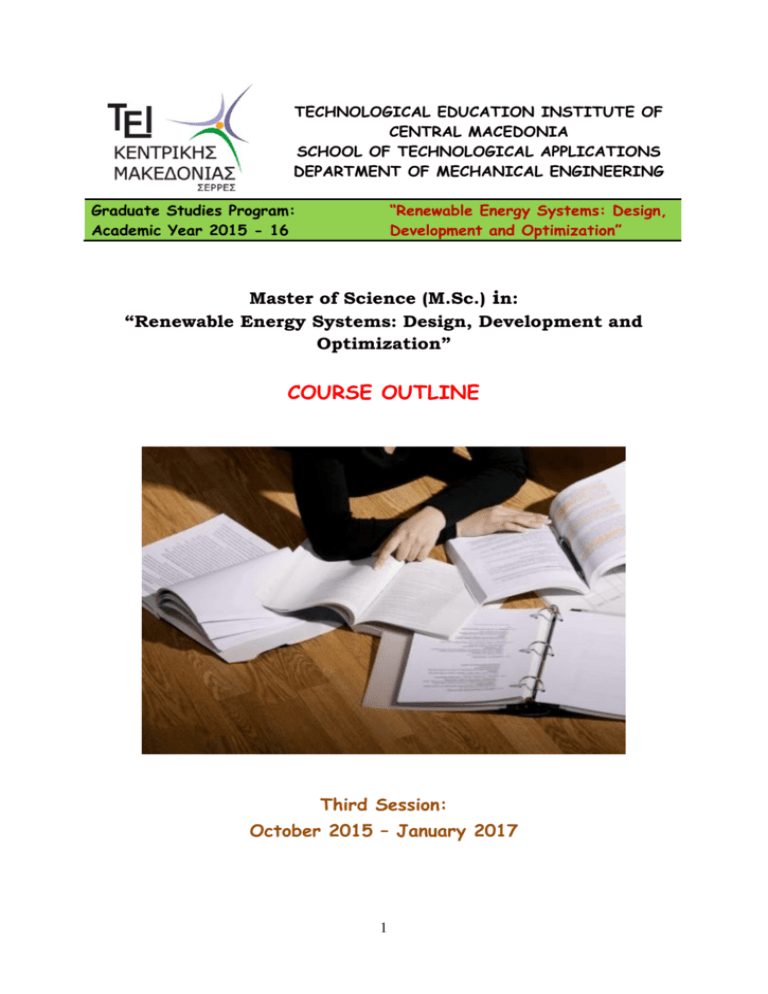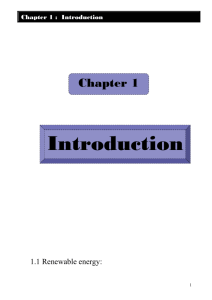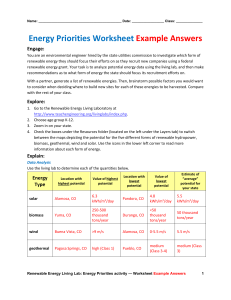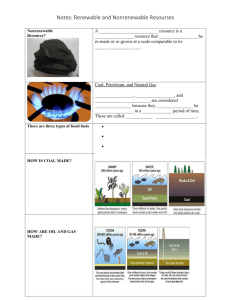Course Outline
advertisement

TECHNOLOGICAL EDUCATION INSTITUTE OF CENTRAL MACEDONIA SCHOOL OF TECHNOLOGICAL APPLICATIONS DEPARTMENT OF MECHANICAL ENGINEERING Graduate Studies Program: Academic Year 2015 - 16 “Renewable Energy Systems: Design, Development and Optimization” Master of Science (M.Sc.) in: “Renewable Energy Systems: Design, Development and Optimization” COURSE OUTLINE Third Session: October 2015 – January 2017 1 Renewable Energy Systems: Design, Development & Optimization October 2015 – January 2017 1st Semester Course 101: APPLIED THERMODYNAMICS Target of Course: The course aims to the application of thermodynamic principles in energy conversion systems. Emphasis is given on the Availability (Exergue) Analysis and its contribution to the evaluation and optimization of thermodynamic processes in renewable energy systems. Course Contents: First and Second Law of Thermodynamics in Closed and Open Systems. Entropy. Consequences of the Second Law. Degradation and Quality of Energy. Entropy Evaluation. Availability (Exergue). Availability Analysis in Closed and Open Systems. Availability Efficiency (Heat engines, heat pumps and refrigerators, work producing and consumption devices, graphical illustration of lost, isentropic and optimum work). Thermodynamic Properties of Mixtures. Bibliography: 1. Ι. Dinçer & M. A. Rosen, “Exergue: Energy, Environment and Sustainable Development”, Elsevier, 2007. 2. K. Annamalai & I. K. Puri, “Advanced Thermodynamics Engineering”, CRC Press, 2002. 3. Y. A. Cengel & M. A. Boles, “Thermodynamics: An Engineering Approach”, (7th Edition) McGraw-Hill, 2011. Course 102 : ADVANCED MATERIALS SCIENCE AND TECHNOLOGY Target of Course: The aim of this course is the acquaintance of the students with the properties of materials which are important in renewable energy applications: Mechanical properties, opto-electronic properties, hydrogen storage materials; knowledge about available materials; material selection. Course Contents: Classification of Materials, atomic bonding, crystal structure, diffusion. Mechanical properties: stress, strain, tension test, hardness test. Phase diagrams, Fe-C system. Martensitic transformation. Commercially available metallic materials: steels, cast irons, copper alloys, aluminum alloys. Composites. Introduction to semiconductors, photovoltaic conversion. Introduction to hydrogen storage. Bibliography: 1. D. R. Askeland & P. P. Phulé, “The Science & Engineering of Materials”, Thomson, Fifth Edition 2006, ISBN 0-534-55396-6. 2 Renewable Energy Systems: Design, Development & Optimization October 2015 – January 2017 2. M. F. Ashby, H. Shercliff & D. Cebon, “Materials: Engineering, Processing and Design”, Butterworth-Heinemann, First Edition 2007, ISBN 978-07506-8391-3. 3. K. Seeger, “Semiconductor Physics: An introduction”, Springer-Verlag, Ninth Edition 2004, ISBN 3-540-21957-9. Course 103 : COMPUTATIONAL MECHANICS Target of Course: The objective of the present course is to integrate finite element theory, problem formulation and computer analysis. The isoparametic concept is introduced at the beginning while considering one-, two- and three- dimensional problems. Both the energy and the Galerkin approaches are used in the development of the stiffness and load matrices and governing equations. Modeling of engineering problems, specifications of the boundary conditions and handling of temperature effects. Pre- and Post-processing concepts are discussed. Deformation and stress analyses are introduced first to solidify the concepts and then a detailed formulation of heat and fluid flow is presented. Design optimization also will be used for the best design to meet our needs. The computational simulation is obtained using ANSYS WORKBENCH finite program. Course Contents: One dimensional problems, trusses in 2D and 3D, two dimensional problems using constant strain triangles, beams and frames in 2D and 3D, three dimensional problems in stress analysis, plate and shell type structures, scalar field problem (steady state heat transfer, potential flow and torsion), vibration and structural dynamics. Bibliography: 1. T.R. Chandrupatla & A.D. Belegundu, “Introduction to Finite Elements in Engineering”, Prentice Hall, Englewood Cliffs, New Jersey, 2003. 2. R. D. Cook, “Concepts and Applications of Finite Analysis”, Willey, New York, 1991. 3. ANSYS WORKBENCH Manual. Course 104 : ENGINEERING ECONOMICS AND COST ANALYSIS Target of Course: The objective of this course is to introduce students to the basics of economics and cost analysis related to engineering, so as to take economically sound decisions. Students will be able to perform economic evaluation and develop cost models for integration with design and operational problem solving. 3 Renewable Energy Systems: Design, Development & Optimization October 2015 – January 2017 Course Contents: The course focuses on economics and cost analysis of engineering projects, giving insights on modern techniques and methods used on economic feasibility studies, relating to design and implementation of engineering projects. Course content will include following topics: Introduction to economics (Flow in an economy, Law of supply and demand, Concept of Engineering Economics – Engineering efficiency, Economic efficiency, Scope of engineering economics, Element of costs, Marginal cost, Marginal Revenue, Sunk cost, Opportunity cost, Break-even analysis-V ratio, Process planning). Value Engineering (Make or buy decision, Value engineering – Function, Aims, Value engineering procedure, Time value of money, Single payment compound amount factor, Single payment present worth factor, Equal payment series sinking fund factor, Equal payment series payment Present worth factor- equal payment series capital recovery factor-Uniform gradient series annual equivalent factor, Effective interest rate). Cash Flow (Methods of comparison of alternatives – present worth method, Future worth method, Annual equivalent method, Rate of return method). Replacement & Maintenance Analysis (Replacement and Maintenance analysis – Types of maintenance, types of replacement problem, determination of economic life of an asset, Replacement of an asset with a new asset – capital recovery with return and concept of challenger and defender, Simple probabilistic model for items which fail completely). Depreciation (Depreciation- Introduction, Straight line method of depreciation, declining balance method of depreciation-Sum of the years digits method of depreciation, sinking fund method of depreciation/Annuity method of depreciation, service output method of depreciation-Evaluation of public alternatives- introduction, Inflation adjusted decisions – procedure to adjust inflation). Bibliography: 1. D. G. Newman, J. P. Lavelle & T. G. Eschenach, “Engineering Economics and Analysis”, 9th Edition, Oxford University Press, 2004. 2. C. S. Park, “Contemporary Engineering Economics”, 4th Edition, Prentice Hall, 2007. 3. L. T. Blank & A. J. Tarquin, “Engineering Economy”, 6th Edition, McGraw-Hill, 2005. 4. J. C. Hartman, “Engineering Economy and the Decision Making Process”, Prentice Hall, 2007. 5. G. J. Thuesen & J. Fabrycky, “Engineering Economy”, 9th Edition, Prentice Hall, 2001. 4 Renewable Energy Systems: Design, Development & Optimization Course 105 : October 2015 – January 2017 ADVANCES IN HEAT TRANSFER Target of Course: The objective of this course is to help students becoming familiar with contemporary concepts in heat transfer, including conservation laws, conduction, laminar and turbulent convection, phase change and radiation. Course Contents: General equation of change of energy. Steady and unsteady state conduction in one, two and three dimensional cases. Finite difference and Finite Element method for steady and unsteady conduction. Forced and free convention heat transfer. Analytical and semi-analytical solutions. Equations for velocity and temperature in vertical and horizontal planes for cylinders heat transfer, liquid metal heat transfer.. Radiation heat transfer concepts. Design of compact heat exchangers. Boiling and Condensation. Selected advanced topics in mass and momentum transfer. Bibliography 1. A. F. Mills, “Heat and Mass Transfer”, Irwin, Chicago, 1995. 2. W. M. Rohsenow & H. Choi, “Heat, Mass and Momentum Transfer”, Prentice Hall, Englewood Cliffs, New Jersey, 1991. 3. F. P. Incropera & D. De Witt, “Fundamentals of Heat &Mass Transfer”, Wiley, New York,1996. 4. J. H. Lienhard, “A Heat Transfer Textbook”, Prentice-Hall, Englewood Cliffs, New Jersey, 1981. 5. F. M. White, “Viscous Fluid Flow”, McGraw-Hill, New York, 1991. 6. H. S. Carslaw & J. C. Jaeger, “Conduction of Heat in Solids”, Clarendon, Oxford, 1986. 7. W. M. Kays & M. E. Crawford, “Convective Heat and Mass Transfer”, McGraw-Hill, New York,1993. 8. A. Bejan, “Convection Heat Transfer”, Wiley, New York, 1995. 9. R. Siegel & J. R. Howell, “Thermal Radiation Heat Transfer”, Hemisphere Publishing Corp., Washington D.C., 1992. 10. T. M. Shih, “Numerical Heat Transfer”, Hemisphere Publishing Corp., Washington D.C., 2002. 5 Renewable Energy Systems: Design, Development & Optimization October 2015 – January 2017 2nd Semester – Foundation Courses Course 201 : MECHANICAL ENGINEERING DESIGN AND OPTIMIZATION Target of Course: The aim of this course is to introduce core engineering themes, principles and modes of thinking. Specialized learning modules such as machine elements, electronics, design process, CAD, mechanism design. Robustness and manufacturability are emphasized. Introduction to FEM analysis, computer aided optimization via simulation. Course Contents: Modern software development techniques and algorithms for engineering computation and for simulating engineering systems. Covers modern tools and methods for product design and development. Topics include product planning, identifying customer needs, concept generation, product architecture, industrial design, concept design and robust design. Introduction to mathematical modeling, optimization, and simulation as applied to manufacturing. Specific methods include linear programming, network flow problems, nonlinear programming discrete – event simulation, computer applications for manufacturing processes and systems. Case studies on optimization of constructions and elements using simulation computer programs. Bibliography: 1. G. Pahl & K. Beitz, “Mechanical Design”, Springer Verlag, 2007. 2. E. Krick, “An Introduction to Engineering and Engineering Design”, John Wiley and Sons, 2003. 3. K. Koller, “Mechanical Engineering Design and Optimization”, Springer Verlag, 2005. Course 202 : COMPUTATIONAL FLUID DYNAMICS Target of Course: The course aims first at introducing the basic concepts of Computational Fluid Dynamics (CFD) technology and then provide practical training of the students in using commercial CFD packages for producing industrial simulations of real applications in the Renewable Energy area. Course Contents: Starting from Taylor series and discretization of PDEs, moving on meshing methods and strategy and concluding with assessing convergence and accuracy of the simulations, the student is getting acquainted with the whole bandwidth of elementary CFD tasks. The finite volume method is briefly discussed to provide a basic theoretical background for the following industrial workshops. 6 Renewable Energy Systems: Design, Development & Optimization October 2015 – January 2017 The latter are real-life models of industrial applications in the RE sector and the student will work from A-to-Z (geometry, mesh, setup, solution, post-processing and reporting) taking into account important issues like cost, available computational power, necessary engineering assumptions and expected accuracy, in order to become familiar with modern industrial CFD practice. Bibliography: 1. J. D. Anderson, “Computational Fluid Dynamics: The Basics with Applications”, Mc Graw-Hill, New York, 1995. 2. S. V. Patankar, “Numerical Heat Transfer and Fluid Flow: Computational Methods in Mechanics and Thermal Science”, Hemisphere Publishing Corp., Washington D.C., 1980. 3. D. C. Wilcox, “Turbulence Modeling for CFD”, DCW Industries, 2006. 4. B. E. Launder & N. D. Sandham, “Closure Strategies for Turbulent and Transitional Flows”, Cambridge University Press, Cambridge, 2002. 5. H. K. Versteeg & W. Malalasekera, “An Introduction to Computational Fluid Dynamics: The Finite Volume Method”, Addison-Wesley, New York, 1996. Course 203 : ENERGY CONVERSION SYSTEMS Target of Course: The objective of this course is to introduce students to the basic principles, technology and latest advances of energy conversion systems. Course Contents: This course focuses on the physical processes and scientific principles involved in the conversion of one energy form to another. Significant emphasis will be given to power production, the conversion of heat to mechanical energy and the utilization of gaseous substances, following the principles of applied thermodynamic and fluid mechanics. The fundamentals of the technology of energy conversion systems, such as steam power plants, gas turbines, internal combustion engines, hydro/wind-turbines and combined-cycle power plants among others, will be presented. Methods for maximizing energy conversion efficiency and the latest advances in renewable energy systems will also be presented. Bibliography: 1. R. Decher, “Energy Conversion: Systems, Flow Physics and Engineering”, Oxford Engineering Science Series, 2003. 2. R. D. Begamudre, “Energy Conversion Systems”, New Age International Publisher, 2006. 7 Renewable Energy Systems: Design, Development & Optimization October 2015 – January 2017 3. D. Y. Goswami & F. Kreith, “Energy Conversion”, CRC Press, 2008. 4. Boyle G., Everett B. & Ramage J. “Energy Systems and Sustainability”, Oxford University Press, 2003. 5. E. S. Cassedy & P. Z. Grossman, “Introduction to Energy: Resources, Technology, and Society”, Cambridge University Press, 1999. 6. A. W. Culp, “Principles of Energy Conversion”, McGraw-Hill, New York, 1979. 7. L. Freris & D. Infield, “Renewable Energy in Power Systems”, John Wiley & Sons, 2005. 8. A. K. Raja, A. P. Srivastava & M. Dwivedi, “Power Plant Engineering”, New Age International Publishers Ltd., 2007. 9. R. C. Bailie, “Energy Conversion Engineering (Energy Science and Technology)”, Addison-Wesley, New York 1998. 2nd Semester – Optional Courses Course E1 : AEOLIAN (WIND) ENERGY SYSTEMS Target of Course: The goal of the course is to help the students develop skills needed for the design of wind energy equipment and wind parks. The course aims to improve the understanding of the main wind energy concepts and the application of general engineering knowledge in the design and construction of wind energy equipment and wind parks. Course Contents: The characteristics of the wind, meteorology, earth boundary layer, wind data, wind data analysis, extreme wind velocities, wind measurements & instrumentation, IEC standards on wind measurements, wind turbine types and classification, horizontal and vertical turbine types, wind turbine power measurements, main aerodynamic calculations for wind turbines, wind turbine components, gear and gearless systems, generators, power electronics used, blades, control equipment, switch gears, grid connection, topography basics used in the wind energy planning, wind turbine and wind park energy analysis, IEC standards for turbine classification, wakes, turbulence analysis, offshore wind energy, wind energy integration in the decentralised power grid, storage systems, hybridisation of wind energy systems. The course includes lectures, independent course work and use of the lab equipment. 8 Renewable Energy Systems: Design, Development & Optimization October 2015 – January 2017 Bibliography: 1. J. Park, “The Wind Power Book”, Cheshire Books, 1981. 2. J. F. Manwell, J. G. McGowan & A. L. Rogers, “Wind Energy Explained”, Wiley, 2001. 3. J. F. Manwell, J. G. McGowan & A. L. Rogers, “Wind Energy Explained: Theory, Design and Application”, 2nd Edition, Wiley, 2009. Course E2 : SOLAR ENERGY SYSTEMS Target of Course: The aim of this course is to introduce students to modern technology for producing energy from the solar thermal and photonic activity. Course Contents: The course will focus on developing student knowledge of solar thermal energy and radiation along with its application. It will provide insights on designing and optimizing modern active and passive solar heating applications as well as to the production of Photovoltaic Power. Course content will include: Basics of Solar radiation. Low-temperature solar energy applications. Active Solar heating, Passive solar heating, Solar Cooling. Solar thermal systems for electricity generation. Photovoltaic Systems (Technologies, PV systems, Grid Connected and Remote Power, Integration in Power Systems) Environmental Impact of Solar Energy Technologies. Bibliography: 1. J. Duffie & W.A. Beckman, “Solar Engineering of Thermal Processes”, John Wiley & Sons, Third edition, 2006. 2. S. Kalogirou, “Solar Energy Engineering: Processes and Systems”, Elsevier, 2009. 3. V. Goetzberger & U. Hoffmann, “Photovoltaic Solar Energy Generation”, Springer-Verlag, 2005. 4. P. Lynn, “Electricity from Sunlight: An Introduction to Photovoltaics”, Wiley, 2010. 5. T. Markvart & L. Castaner, “Practical Handbook of Photovoltaics: Fundamentals and Applications”, Elsevier, 2003. 6. G. Boyle (Editor), “Renewable Energy”, Oxford University Press, 2004. 9 Renewable Energy Systems: Design, Development & Optimization October 2015 – January 2017 7. G. Boyle (Editor), “Renewable Electricity and the Grid. The Challenge of Variability”, Earthscan, 2007. 8. L. Freris & D. Infield, “Renewable Energy in Power Systems”, Wiley, 2008. 9. M. Kaltschmitt, W. Streicher & A. Wiese (Editors), “Renewable energy: Technology, Economics and Environment”, Springer, 2007. 10. B. Sorensen, “Renewable Energy”, Elsevier, 2004. Course E3 : GEOTHERMAL ENERGY SYSTEMS Target of Course: The aim of this course is to introduce students to modern technology that takes advantage of the Earth’s interior activity in order to produce energy. Course Contents: The course covers both theoretical aspects as well as real cases in the following subjects: Geothermal Energy Hydrothermal fields. Sedimentary basins. Hot dry rock systems. Technology and practical problems. Geothermal energy for space heating and cooling applications (Thermal efficiency, Capacity/load factors, Geothermal heat pumps) Geothermal energy for electrical power applications Economics of Geothermal Systems Regulations and environmental aspects Greenhouse heating, aquaculture Industrial processes Well drilling, Geothermal drilling risks Bibliography: 1. M. H. Dickson & M. Fanelli, “Geothermal Energy: Utilization and Technology”, McGraw-Hill, New York, 2001. 2. E. Huenges & P. Ledru, “Geothermal Energy Systems: Exploration, Development, and Utilization”, Wiley, New York, 1995. 3. D. Banks, “An Introduction to Thermo-geology: Ground Source Heating and Cooling”, Prentice-Hall, Englewood Cliffs, N.J., 1993. 10 Renewable Energy Systems: Design, Development & Optimization October 2015 – January 2017 4. R. G. Bloomquist, “Geothermal Heat Pumps: Four Plus Decades of Experience”, Geo-Heat Centre Quarterly Bulletin (Klamath Falls, Oregon: Oregon Institute of Technology), 1999, ISSN 0276-1084. 5. J. Lund, B. Sanner, L. Rybach, R. Curtis & G. Hellström, “Geothermal (Ground Source) Heat Pumps: A World Overview”, Geo-Heat Centre Quarterly Bulletin (Klamath Falls, Oregon: Oregon Institute of Technology), 2004, ISSN 0276-1084. Course E4 : MODERN BIOMASS ENERGY SYSTEMS Target of Course: The goal of the course is to develop skills needed for the design of Biomass & Biogas energy equipment and power plants. The course aims to improve the understanding of the main biomass & biogas energy concepts and the application of general engineering knowledge in the design and construction of biomass & biogas energy equipment and power plants. Course Contents: The characteristics of the biomass, combustion, gasification, pyrolisis, biomass processing, equipment, the biomass power plant, the biomass stoichiometry, the chemistry and fundamentals of biomass combustion and gasification, biomass emissions, biomass resource planning, biomass residuals, the use of thermal cycles for power generation, ORCs, current trends in the use of biomass. Biogas fundamentals, the biochemistry of biogas formation, biogas plants, the digester, waste processing for biogas generation, residuals processing, biogas processing for power generation, the biogas power plant, grid connection of biomass & biogas power plants. Bibliography: 1. R. Sims, “The Brilliance of Bio-energy”, James & James, 2002. 2. “Biomass CHP Best Practice Guide”, EC AlterNet Program, 2006. 3. D. Deubein & A. Steinhauser, “Biogas from Waste and Renewable Resources: An Introduction”, 2nd, Revised and Expanded Edition, Willey, 2010. Course E5 : HYDROGEN TECHNOLOGY AND APPLICATIONS Target of Course: Hydrogen is not in and of itself an energy source, because it is not naturally occurring as a fuel. It is, however, widely regarded as an ideal energy storage medium, due to the ease with which electric power can convert water into its hydrogen and oxygen components through electrolysis. The aim of this course is to introduce students to modern technology related to the production and use of hydrogen. 11 Renewable Energy Systems: Design, Development & Optimization October 2015 – January 2017 Course Contents: Fuel Cells and Hydrogen Technology. The “Gas Battery”. The “Bacon fuel cell”. Fuel cells used by NASA. The Polymer Electrolyte Membrane (PEM) fuel cell. Ballard Power. Chemistry of a single cell. Voltage and efficiency. Hydrogen Infrastructure. Compressors. Combustion Engines. Hydrogen Storage. Power generation. Grid-connect applications. Non-grid-connect applications. Residential Power. Portable Power. Hydrogen-moving vehicles. Bibliography: 1. M. Berry & A. McDonald, “Energy Through Hydrogen”, Heliocentris, 2000. 2. T. Koppel, “Powering the Future”, John Wiley & Sons, 1999. 3. J. Larminie & A. Dicks, “Fuel Cell Systems Explained”, John Wiley & Sons, 2000. 4. M. Hirscher & K. Hirose, “Handbook of Hydrogen Storage: New Materials for Future Energy Storage”, Wiley-VCH Verlag GmBH & Co. KGaA, 2010, ISBN 978-3-527-32273-2. USEFUL LINK Please use the following link, to download: The M.Sc. Program Course Outline (in English). The Director of the M.Sc. Studies Program, Professor Anastasios MOISSIADIS 12





